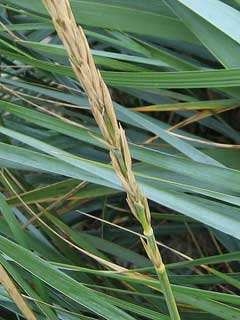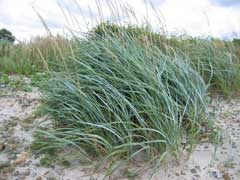 |
|
http://commons.wikimedia.org/wiki/User:Fabelfroh |
 |
| http://commons.wikimedia.org/wiki/User:Fabelfroh |
Translate this page:
Summary
Physical Characteristics

 Leymus arenarius is a PERENNIAL growing to 1.2 m (4ft) by 2 m (6ft 7in) at a fast rate.
Leymus arenarius is a PERENNIAL growing to 1.2 m (4ft) by 2 m (6ft 7in) at a fast rate.
See above for USDA hardiness. It is hardy to UK zone 6 and is not frost tender. It is in flower from May to July, and the seeds ripen from September to October. The species is hermaphrodite (has both male and female organs) and is pollinated by Wind.
Suitable for: light (sandy), medium (loamy) and heavy (clay) soils, prefers well-drained soil and can grow in nutritionally poor soil. Suitable pH: mildly acid, neutral and basic (mildly alkaline) soils. It cannot grow in the shade. It prefers dry or moist soil and can tolerate drought. The plant can tolerate maritime exposure.
UK Hardiness Map
US Hardiness Map
Synonyms
Leymus arenarius. (L.)Hochst.
Plant Habitats
Ground Cover;
Edible Uses
Edible Parts: Seed
Edible Uses:
Seed - cooked[2, 105]. It can be ground into a flour and used to make bread[13]. A delicious taste[183] but very fiddly to use, the seed is small and hard to extract[K]. When cooked like rice, it can be used as a sweet or savoury dish. Mixed 50/50 with wheat flour it adds a richness to biscuits etc[183]. The protein content of this grain is said to rival that of red beans or salmon[183]. (This report seems somewhat surprising, protein levels are not usually anywhere near that high in a cereal[K].)
References More on Edible Uses
Medicinal Uses
Plants For A Future can not take any responsibility for any adverse effects from the use of plants. Always seek advice from a professional before using a plant medicinally.
None known
References More on Medicinal Uses
The Bookshop: Edible Plant Books
Our Latest books on Perennial Plants For Food Forests and Permaculture Gardens in paperback or digital formats.

Edible Tropical Plants
Food Forest Plants for Hotter Conditions: 250+ Plants For Tropical Food Forests & Permaculture Gardens.
More

Edible Temperate Plants
Plants for Your Food Forest: 500 Plants for Temperate Food Forests & Permaculture Gardens.
More

More Books
PFAF have eight books available in paperback and digital formats. Browse the shop for more information.
Shop Now
Other Uses
Fibre Soil stabilization Weaving
The leaves are used for making mats, rope, paper etc[46, 61]. The plants have a very extensive root system and so they are often planted near the coast in order to stabilize sand dunes[190, 200]. They can also be used as a ground cover for sandy open spaces but can be invasive[200, 208].
Special Uses
Carbon Farming Ground cover
References More on Other Uses
Cultivation details
Staple Crop: Balanced carb Wild-collected as Food
An easily grown plant, it succeeds in most soils, preferring a sandy soil[1] and a sunny position[162]. Established plants are very drought tolerant[190]. A very invasive plant, spreading by means of its wide-ranging roots[1, 187]. Cultivated in Japan for making mats etc[46, 61]. The Viking settlers of Iceland cultivated this plant until the beginning of the 20th century for its edible seed[183].
Carbon Farming
-
Staple Crop: Balanced carb
(0-15 percent protein, 0-15 percent oil, with at least one over 5 percent). The carbohydrates are from either starch or sugar. Annuals include maize, wheat, rice, and potato. Perennials include chestnuts, carob, perennial fruits, nuts, cereals, pseudocereals, woody pods, and acorns.
-
Wild-collected as Food
Some wild plants have strong historic or contemporary use. Although they are not cultivated crops, they may be wild-managed.
References Carbon Farming Information and Carbon Sequestration Information
Temperature Converter
Type a value in the Celsius field to convert the value to Fahrenheit:
Fahrenheit:
The PFAF Bookshop
Plants For A Future have a number of books available in paperback and digital form. Book titles include Edible Plants, Edible Perennials, Edible Trees,Edible Shrubs, Woodland Gardening, and Temperate Food Forest Plants. Our new book is Food Forest Plants For Hotter Conditions (Tropical and Sub-Tropical).
Shop Now
Plant Propagation
Seed - sow mid spring in situ and only just cover the seed[162]. Germination should take place within 2 weeks. If the supply of seed is limited, it can also be sown in mid spring in a cold frame. Only just cover the seed. When large enough to handle, prick the seedlings out into individual pots and plant them out in summer[K] Division in spring or summer[162]. Very easy, larger clumps can be replanted direct into their permanent positions, though it is best to pot up smaller clumps and grow them on in a cold frame until they are rooting well. Plant them out in the spring.
Other Names
If available other names are mentioned here
Native Range
EUROPE: Denmark, Finland, United Kingdom, Iceland, Norway, Sweden, Belgium, Germany, Netherlands, Russian Federation-European part (European part (north)), Estonia, Lithuania, Latvia, Spain (northwest), France
Weed Potential
Right plant wrong place. We are currently updating this section.
Please note that a plant may be invasive in one area but may not in your area so it's worth checking.
Conservation Status
IUCN Red List of Threatened Plants Status :

Growth: S = slow M = medium F = fast. Soil: L = light (sandy) M = medium H = heavy (clay). pH: A = acid N = neutral B = basic (alkaline). Shade: F = full shade S = semi-shade N = no shade. Moisture: D = dry M = Moist We = wet Wa = water.
Now available:
Food Forest Plants for Mediterranean Conditions
350+ Perennial Plants For Mediterranean and Drier Food Forests and Permaculture Gardens.
[Paperback and eBook]
This is the third in Plants For A Future's series of plant guides for food forests tailored to
specific climate zones. Following volumes on temperate and tropical ecosystems, this book focuses
on species suited to Mediterranean conditions—regions with hot, dry summers and cool, wet winters,
often facing the added challenge of climate change.
Read More
Expert comment
Author
(L.)Hochst.
Botanical References
117200
Links / References
For a list of references used on this page please go here
Readers comment
© 2010, Plants For A Future. Plants For A Future is a charitable company limited by guarantee, registered in England and Wales. Charity No. 1057719, Company No. 3204567.